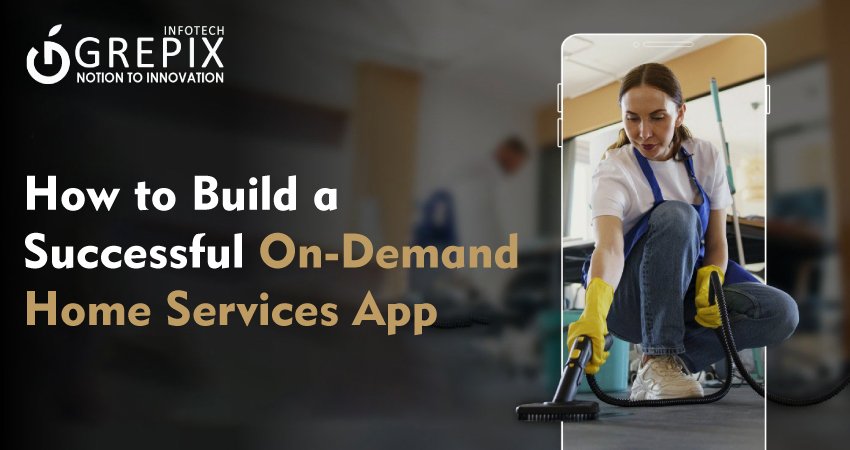How to Build a Successful On-Demand Home Services App
The on-demand home services industry has experienced explosive growth in recent years, revolutionizing how consumers access professional services. With the global online on-demand home services market projected to reach $19.65 billion by 2033, growing at a CAGR of 16.04%, businesses are increasingly investing in on-demand app development solutions to capitalize on this lucrative opportunity.
Building a successful home services app requires strategic planning, advanced technology, and deep understanding of user needs. Whether you're considering clone app solutions or custom development, this comprehensive guide will walk you through every essential step to create a profitable platform. As the future of on-demand apps continues to evolve with AI integration and IoT capabilities, now is the perfect time to enter this thriving market.
This comprehensive guide explores building successful on-demand home services apps in today's growing digital marketplace. With the global market projected to reach $19.65 billion by 2033, entrepreneurs have significant opportunities for profitable ventures. The article covers essential development aspects including market research, feature requirements, technology selection, and monetization strategies. Key topics include customer and provider app features, administrative panel capabilities, development costs ranging from $30,000 to $300,000, and emerging trends like AI integration and IoT connectivity. Clone app solutions offer cost-effective alternatives, reducing expenses by 60% and launch times to 3-5 weeks, making market entry accessible for startups and established businesses seeking digital transformation.
Understanding the On-Demand Home Services Market
The on-demand home services market has transformed from a niche convenience into a mainstream necessity. The industry encompasses everything from cleaning and plumbing to beauty services and handyman work, creating a comprehensive ecosystem that serves millions of customers worldwide.
Market statistics reveal remarkable growth potential. The global market size was valued at $5.24 billion in 2024 and is expected to grow to $5.95 billion in 2025. In the United States alone, the market is projected to surpass $1.4 trillion by 2030, demonstrating the massive opportunity for entrepreneurs and established businesses alike.
Several key factors drive this growth. Increasing urbanization has created busy lifestyles where consumers lack time for household maintenance. The rise of dual-income households has further fueled demand for professional services, while smartphone penetration reaching 98% among adults aged 16-24 has made digital service booking the preferred method for most consumers.
Why Invest in a Home Services App?
Investing in on-demand app development for home services offers numerous compelling advantages that make it an attractive business opportunity. The sector's resilience and consistent demand create a stable foundation for long-term success.
The market presents low barriers to entry compared to traditional service businesses. Unlike starting a physical service company that requires significant equipment and facility investments, a home services app connects existing professionals with customers, eliminating inventory and operational overhead costs.
Revenue potential is substantial through multiple monetization streams. Commission-based models typically charge service providers 10% to 30% per transaction, while subscription services, advertising revenue, and featured listings provide additional income sources. The scalability of clone app solutions enables rapid expansion into new markets and service categories without proportional cost increases.
Consumer behavior strongly favors digital platforms. 89% of consumers expect services to be available on-demand, and 70% prefer eco-friendly service options, indicating opportunities for specialized niches. The integration of smart home technology, with the market growing from $174 billion in 2025 to $250.6 billion by 2029, creates additional revenue opportunities through advanced service offerings.
Key Features of a Home Services App
Customer App Features
The customer-facing application serves as the primary touchpoint for users seeking home services. Essential features begin with streamlined registration and login processes that support social media integration, email, and phone number verification. Advanced search functionality enables users to filter services by location, price range, availability, and specialty, ensuring they find the right professional quickly.
GPS-based tracking provides real-time visibility into service provider locations and estimated arrival times. This transparency builds trust and reduces customer anxiety about appointment timing. Secure payment integration supporting multiple methods including credit cards, digital wallets, and cash-on-delivery options ensures seamless transactions.
The rating and review system creates accountability while helping future customers make informed decisions. Push notifications keep users engaged with booking confirmations, service updates, and promotional offers. Schedule management allows flexible appointment booking with options for immediate, scheduled, or recurring services.
Service Provider App Features
Service providers require a comprehensive mobile interface to manage their business operations efficiently. Profile management capabilities allow professionals to showcase credentials, certifications, and service portfolios. Real-time request management enables providers to accept or decline job offers based on availability and location preferences.
In-app messaging facilitates direct communication between providers and customers for service clarification and coordination. Earnings tracking and payment management provide transparency into compensation and payout schedules. Calendar integration helps providers manage their schedule and avoid booking conflicts.
Performance analytics show rating trends, customer feedback, and booking statistics to help providers improve service quality. Document management features support license verification and insurance documentation, building customer trust through verified credentials.
Admin Panel Features
The administrative dashboard serves as the control center for the entire platform. User management tools oversee customer and provider accounts, handling verification, suspension, and profile updates. Service management capabilities allow administrators to add new service categories, update pricing structures, and manage service descriptions.
Order management systems track all transactions from booking to completion, enabling dispute resolution and quality control. Payment and commission management handles all financial transactions, including provider payouts and commission calculations. Analytics and reporting provide comprehensive business intelligence through revenue tracking, user engagement metrics, and service performance data.
Marketing tools enable promotional campaign management, discount codes, and push notification broadcasting. Customer support integration provides ticketing systems and communication tools for resolving user issues promptly.
Essential Steps to Build a Home Services App
Market Research & Target Audience Analysis
Comprehensive market research forms the foundation of successful on-demand app development. Begin by analyzing local market conditions, identifying service gaps, and understanding competitor positioning. Survey potential customers to understand pain points, preferred services, and willingness to pay for convenience.
Demographics research should focus on urban professionals, dual-income households, and elderly consumers who represent the primary target markets. Geographic analysis helps determine initial launch locations based on population density, smartphone adoption, and existing service provider availability.
Competitive analysis should examine existing platforms like Urban Company, TaskRabbit, and Handy to identify differentiation opportunities. Study their pricing models, service offerings, and customer feedback to discover market gaps your app can fill.
Choosing the Right Business Model
The business model significantly impacts long-term profitability and growth potential. Commission-based models remain the most popular, charging service providers a percentage of each transaction. This approach aligns platform success with provider earnings, creating sustainable growth incentives.
Subscription models offer predictable revenue streams by charging customers monthly or annual fees for premium features like priority booking or discounted services. Hybrid models combining commissions and subscriptions maximize revenue opportunities while providing flexibility for different user segments.
Freemium models attract large user bases through free basic services while monetizing premium features. This approach works particularly well for clone app solutions seeking rapid market penetration and user acquisition.
Designing a Seamless User Experience
User experience design directly impacts customer retention and engagement. Start with intuitive navigation that minimizes steps between service discovery and booking. Visual hierarchy should prioritize frequently used features while maintaining clean, uncluttered interfaces.
Mobile-first design ensures optimal performance across devices and screen sizes. Implement responsive layouts that adapt to different platforms while maintaining consistent functionality. Consider accessibility requirements to serve users with disabilities and expand your potential market.
User journey mapping identifies potential friction points and optimization opportunities. Test registration processes, booking flows, and payment systems to ensure smooth user experiences that encourage repeat usage.
Selecting the Right Technology Stack
The technology stack determines app performance, scalability, and maintenance requirements. For on-demand app development, consider cross-platform frameworks like Flutter or React Native for efficient multi-platform deployment. These solutions reduce development time and costs while maintaining native-like performance.
Backend technologies should prioritize real-time capabilities and scalability. Node.js provides excellent real-time functionality for tracking and notifications, while Python with Django offers robust security and scalability features. Cloud hosting through AWS, Google Cloud, or Azure ensures reliable infrastructure that scales with user growth.
Database selection impacts performance and data management capabilities. PostgreSQL provides strong relational data handling, while MongoDB offers flexibility for evolving data structures. GPS and mapping integration through Google Maps API or Mapbox enables location-based matching and tracking features essential for home services.
Development & Testing
Development should follow agile methodologies to enable iterative improvements and rapid feature deployment. Begin with MVP development focusing on core features like user registration, service booking, provider matching, and basic payment processing. This approach reduces time-to-market while enabling early user feedback collection.
Quality assurance testing must cover functionality, performance, security, and compatibility across multiple devices and operating systems. Implement automated testing frameworks to streamline regression testing and ensure consistent quality standards.
Security testing is particularly crucial given the personal data and payment information involved in home services transactions. Implement data encryption, secure authentication protocols, and compliance with relevant data protection regulations.
Launch & Marketing Strategy
Pre-launch preparation should include app store optimization with keyword-rich descriptions and compelling visuals. Build anticipation through social media campaigns and early-bird promotions targeting your identified customer segments.
Launch strategy should focus on specific geographic markets rather than broad deployment. This approach enables concentrated marketing efforts and better customer support during initial scaling. Partner with local service providers to ensure adequate supply availability.
Post-launch marketing should emphasize referral programs, user-generated content, and local SEO optimization. Monitor user feedback closely and implement rapid improvements to address early adoption challenges.
Cost of Building an On-Demand Home Services App
Development costs vary significantly based on feature complexity, platform requirements, and development location. Basic home services apps start around $30,000 to $60,000, while advanced platforms with AI integration and comprehensive features can exceed $300,000.
Geographic location significantly impacts development costs. US-based development typically costs $80-150 per hour, Western Europe ranges $50-120 per hour, while India-based development offers $20-80 per hour. These cost differences make offshore development attractive for budget-conscious startups.
Clone app solutions provide substantial cost savings, reducing development expenses by up to 60% while shortening launch timelines to 3-5 weeks. This approach leverages proven architectures and features, minimizing technical risks while enabling customization for specific market needs.
Cost breakdown typically includes design (up to $25,000), frontend development ($30,000-50,000), backend development (up to $50,000), third-party integrations ($20,000+), and testing ($20,000). Ongoing maintenance costs approximately 20-25% of initial development expenses annually.
Challenges and How to Overcome Them
The competitive landscape presents the primary challenge for new entrants. With over 6.1 million professional service apps projected to reach 7.2 million by 2028, differentiation becomes crucial. Focus on underserved niches, superior customer experience, or innovative features to stand out from established competitors.
Device compatibility across multiple screen sizes and operating systems requires comprehensive testing and responsive design implementation. Adopt cross-platform development frameworks and maintain consistent user experiences across all devices to address this challenge effectively.
Security concerns regarding personal data and payment processing demand robust protection measures. Implement encryption, secure authentication, regular security audits, and compliance with data protection regulations to build user trust.
Provider quality control presents ongoing operational challenges. Develop thorough vetting processes including background checks, skill assessments, and ongoing performance monitoring. Implement transparent rating systems and provide continuous training programs to maintain service quality standards.
User acquisition and retention in saturated markets require strategic marketing investments. Develop comprehensive acquisition strategies including SEO, social media marketing, influencer partnerships, and referral programs. Focus on customer lifetime value optimization rather than just initial acquisition costs.
Also Read: "On-Demand App Development Trends to Watch in 2025"
Future Trends in On-Demand Home Services Apps
The future of on-demand apps is being shaped by emerging technologies and changing consumer expectations. Artificial Intelligence integration is revolutionizing personalized service recommendations, predictive maintenance scheduling, and automated customer support through chatbots. AI-powered matching algorithms improve provider-customer compatibility while optimizing route efficiency for service delivery.
Internet of Things (IoT) integration enables smart home connectivity, allowing apps to interface directly with home automation systems. This technology facilitates automated service scheduling based on device usage patterns and enables remote diagnostics for appliance maintenance.
Augmented Reality (AR) adoption is growing by 40% in interior design applications, allowing customers to visualize service outcomes before booking. Virtual consultations through AR and VR technologies expand service accessibility while reducing travel costs for providers.
Sustainability focus reflects growing environmental consciousness, with 70% of consumers preferring eco-friendly services. Apps incorporating green service options and carbon footprint tracking will gain competitive advantages as environmental awareness increases.
Subscription-based services are gaining traction, with 52% adoption in recurring service models. This trend toward predictable revenue streams benefits both platforms and customers through improved service planning and cost management.
Voice-activated AI integration represents significant growth potential, with the market expected to reach $514.62 billion by 2034. Smart speakers and voice assistants will enable hands-free service booking and status updates, improving convenience and accessibility.
How Appicial Can Help You Build a Home Services App
Appicial specializes in comprehensive on-demand app development solutions, offering both custom development and proven clone app solutions for entrepreneurs entering the home services market. With expertise spanning taxi apps, food delivery, logistics, and home services, Appicial provides end-to-end development services from concept to deployment.
Their HouseJoy clone script offers a complete solution for entrepreneurs seeking rapid market entry. The platform includes customer apps, service provider apps, and administrative panels with advanced features like real-time tracking, secure payments, and comprehensive service management tools. The solution supports multiple service categories from cleaning and plumbing to beauty services and maintenance.
Appicial's development process emphasizes customization and scalability, ensuring solutions adapt to specific market requirements and business models. Their experience with on-demand platforms across various industries provides valuable insights for optimizing user experience and operational efficiency.
Technical expertise includes modern development frameworks, cloud integration, and third-party API implementations essential for competitive home services platforms. Post-launch support includes maintenance, updates, and feature enhancements to ensure long-term success and market competitiveness.
Conclusion
Building a successful on-demand home services app requires strategic planning, technical expertise, and deep market understanding. The industry's robust growth trajectory, with projections reaching $19.65 billion by 2033, creates substantial opportunities for well-executed platforms. Success depends on comprehensive market research, user-centric design, advanced technology implementation, and effective marketing strategies.
On-demand app development offers multiple pathways to profitability through commission-based models, subscription services, and advertising revenue. Clone app solutions provide cost-effective entry points while custom development enables unique differentiation in competitive markets. The future of on-demand apps promises continued innovation through AI integration, IoT connectivity, and enhanced user experiences.
Key success factors include thorough market research, appropriate technology selection, robust security implementation, and continuous quality improvement. Challenges around competition, technical complexity, and user acquisition are manageable through strategic planning and professional development partnerships. As consumer preferences continue favoring digital convenience and on-demand accessibility, home services apps represent sustainable business opportunities for entrepreneurs and established companies alike.
The time for market entry is optimal given current growth trends and technology maturity. Whether pursuing custom development or clone app solutions, focus on delivering exceptional user experiences, maintaining high service quality, and building trust through transparent operations. With proper execution and strategic partnerships, your home services app can capture significant market share in this rapidly expanding industry.
Ready to transform your home services business idea into reality? Contact professional development teams today to begin your journey toward building a successful on-demand platform that meets modern consumer demands and generates sustainable revenue growth.
FAQs
1. How much does it cost to build an on-demand app?
Custom apps cost between $30,000 to $200,000, while clone app solutions can be developed for $10,000 to $50,000.
2. Why are clone app solutions popular among startups?
They save development time, reduce costs, and provide tested, market-ready features.
3. What technologies are shaping the future of on-demand apps?
AI, blockchain, AR, and voice-enabled commerce are leading innovations.
4. Are on-demand apps scalable?
Yes, scalable cloud infrastructure ensures apps can handle growing user demands.
5. How do clone apps ensure security?
Modern clone app solutions integrate security features like encryption, multi-factor authentication, and GDPR compliance.







